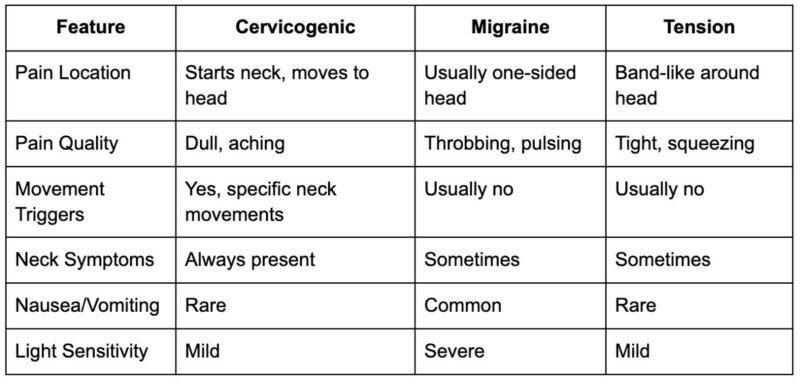Cervicogenic Headache Symptoms: What You Need to Know

If you’re dealing with pain that begins in your neck and radiates upward, you might be experiencing cervicogenic headache symptoms. Unlike typical migraines or tension headaches, these unique headaches originate from problems in your cervical spine – and the good news is they’re highly treatable. Understanding cervicogenic headache causes and recognizing the distinct symptoms can be the first step toward finally finding lasting relief.
What Is a Cervicogenic Headache?
A cervicogenic headache is essentially a “referred pain” headache that starts in your neck but makes your head hurt. Think of it like a domino effect – when something goes wrong in your upper cervical spine, the pain travels along nerve pathways to create headache symptoms.
These cervical spine headaches develop when joints, muscles, or nerves in your upper neck become irritated or inflamed. The pain then follows specific nerve pathways, creating a headache pattern that’s distinctly different from primary headaches.
What sets cervicogenic headaches apart from migraines or tension headaches is their origin point. While migraines stem from vascular changes in the brain and tension headaches typically involve muscle tightness around the skull, cervicogenic headaches have a mechanical cause – dysfunction in the neck itself.
Common Symptoms of Cervicogenic Headaches
Recognizing these specific symptoms helps distinguish cervicogenic headaches from other types.
- Pain starting in the neck and radiating upward is the hallmark symptom. Patients tell us it feels like the pain “crawls up” from the base of their skull to their temple or behind their eye.
- One-sided head pain occurs in about 90% of cases. Unlike tension headaches that typically affect both sides, cervicogenic headaches usually stick to one side of your head. The pain may switch sides occasionally, but it rarely affects both sides simultaneously.
- Neck stiffness and reduced range of motion accompany the headache pain. You might notice difficulty turning your head fully to one side or looking up and down. This stiffness often predicts when a headache is coming.
- Movement-triggered pain sets cervicogenic headaches apart from other types. Specific neck movements, like turning your head quickly or holding certain positions, can instantly trigger or worsen the headache.
- Associated symptoms round out the picture and may include:
- Dizziness or balance issues
- Blurred vision or light sensitivity
- Shoulder and upper arm discomfort
- Nausea (though less common than with migraines)
See more: Chiropractic Care and Headaches: A Comprehensive Look
Cervicogenic Headache vs. Migraine and Tension Headaches

Causes and Risk Factors
Cervical spine problems form the foundation of most cervicogenic headaches. Arthritis in the upper neck joints, herniated discs, and previous injuries like whiplash all create dysfunction that can trigger headaches.
Poor posture from sedentary jobs has become increasingly common. Over time, this leads to joint dysfunction, muscle imbalances, and eventually headaches.
Previous neck injuries often set the stage for future problems. Even minor car accidents, sports injuries, or falls can create lasting changes in how your cervical spine moves and functions.
Age-related degeneration affects everyone differently. As we age, the discs between our vertebrae lose water content and height. The joints may develop arthritis, and ligaments become less flexible.
Lifestyle and occupational factors significantly influence your risk:
- Desk jobs requiring prolonged computer use
- Professions involving repetitive neck movements
- High-stress occupations that increase muscle tension
- Poor sleep habits and inadequate pillow support
- Lack of regular exercise leading to weak neck muscles
How Chiropractic Care Targets the Root Cause
Research by Haas et al. (2010) showed chiropractic care reduced cervicogenic headache frequency by 69% and intensity by 36%. These results happen because we’re actually fixing the underlying problem, not just covering up symptoms.
- Chiropractic adjustments restore proper movement to restricted joints in your upper neck. When these joints don’t move correctly, they send abnormal signals that trigger headaches. Our gentle adjustments fix this problem at its source.
- Soft tissue therapy releases muscle tension and trigger points using techniques like myofascial release. This improves blood flow and restores normal muscle function in your neck and shoulders.
- Posture correction and ergonomic guidance prevent future episodes. Simple changes to your workspace or pillow can dramatically reduce headache frequency.
Take Control of Your Cervicogenic Headaches Today
Recognizing cervicogenic headache symptoms is the first step toward lasting relief. If your headaches start in your neck, worsen with movement, and affect one side of your head, you’re likely dealing with a treatable cervicogenic headache.
At Chiropractic Care Centre in Tampa, FL, we specialize in treating headaches from neck issues. Our approach addresses the underlying dysfunction, not just the symptoms.
Don’t suffer another day with headaches that can be easily treated. Contact us today to discover how chiropractic care can provide the natural, lasting relief you’ve been searching for.
FAQs
What does a cervicogenic headache feel like?
Most patients describe it as a deep, aching pain that starts at the base of the skull and travels forward. Unlike sharp, stabbing pains, cervicogenic headaches tend to be more constant and dull. The pain often feels like pressure building behind one eye or temple.
How can I tell if my headache is from my neck?
The easiest way is to notice if neck movement affects your headache. Try gently turning your head or pressing on the muscles at the base of your skull. If these actions change your headache pain, there’s likely a cervical component involved.
Can poor posture really cause headaches?
Absolutely. Forward head posture increases the load on your cervical spine exponentially. For every inch your head moves forward, it adds approximately 10 pounds of stress to your neck muscles. This chronic overload eventually leads to joint dysfunction and headaches.
Is chiropractic care safe and effective for cervicogenic headaches?
Chiropractic care is both safe and highly effective for cervicogenic headaches. Serious complications are extremely rare, and research consistently shows significant improvement in both headache frequency and intensity with chiropractic treatment.




